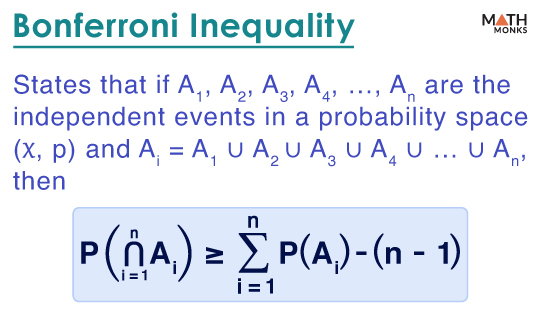Bonferroni inequality states that the probability of intersections between ‘n’ independent events is always greater than or equal to the difference between the sum of the events and 1 less than the total number of events.
Mathematically, it is written as
If ‘A1,’ ‘A2,’ …, ‘An’ are the independent events in a probability space (X, p) and Ai = A1 ∪ A2 ∪ … ∪ An, then
${P\left( \cap ^{n}_{i=1}A_{i}\right) \geq \sum ^{n}_{i=1}P\left( A_{i}\right) -\left( n-1\right)}$
Proof
Let us prove Bonferroni’s inequality using mathematical induction.
Base Step
For n = 1, P(A1) ≥ 1 – 1 + P(A1) = P(A1), which is true.
For n = 2, by De Morgan’s law, P((A1 ∩ A2)c) = P(A1c ∪ A2c) ≤ P(A1c) + P(A2c)
⇒ P((A1 ∩ A2)c) ≤ P(A1c) + P(A2c)
⇒ 1 – P(A1 ∩ A2) ≤ 1 – P(A1) + 1 – P(A2)
⇒ 1 – P(A1 ∩ A2) ≤ 2 – P(A1) – P(A2)
⇒ P(A1 ∩ A2) ≥ P(A1) + P(A2) – (2 – 1), which is true.
Inductive Step
Let us assume Bonferroni’s inequality holds for n = m.
We have
${P\left( \cap ^{m}_{i=1}A_{i}\right) \geq \sum ^{m}_{i=1}P\left( A_{i}\right) -\left( m-1\right)}$ …..(i)
Now, assuming n = m + 1, we get
${P\left( \cap ^{m+1}_{i=1}A_{i}\right)}$
= ${P\left[ \left( \cap ^{m}_{i=1}A_{i}\right) \cap A_{m+1}\right]}$
= ${P\left( \cap ^{m} _{i=1}A_{i}\right) +P\left( A_{m+1}\right) -P\left[ \left( \cap ^{m}_{i=1}A_{i}\right) \cup A_{m+1}\right]}$
From (i), we have
${P\left( \cap ^{m+1}_{i=1}A_{i}\right)\geq \sum ^{m}_{i=1}P\left( A_{i}\right) -m+1+P\left( A_{m+1}\right) -P\left[ \left( \cap ^{m}_{i=1}A_{i}\right) \cup A_{m+1}\right]}$
⇒ ${P\left( \cap ^{m+1}_{i=1}A_{i}\right)\geq \sum ^{m+1}_{i=1}P\left( A_{i}\right) -m+1-P\left[ \left( \cap ^{m}_{i=1}A_{i}\right) \cup A_{m+1}\right]}$ …..(ii)
By the definition of probability, the last term of (ii) can not exceed 1.
Thus, ${P\left( \cap ^{m+1}_{i=1}A_{i}\right)\geq \sum ^{m+1}_{i=1}P\left( A_{i}\right) -m+1-1}$
⇒ ${P\left( \cap ^{m+1}_{i=1}A_{i}\right)\geq \sum ^{m+1}_{i=1}P\left( A_{i}\right) -\left[ \left( m+1\right) -1\right]}$, which shows that if the statement holds for n = m, then it is also true for n = m + 1.
Thus, Bonferroni’s inequality is proved.
Alternative Form
Bonferroni inequality in the generalized form states that if ‘A1,’ ‘A2,’ …, ‘An’ are random events in a probability space (X, p) and Ai = A1 ∪ A2 ∪ … ∪ An, then the upper and lower bounds for P(A) are:
${P\left( A_{i}\right) \leq \sum ^{m}_{k=1}\left( -1\right) ^{k-1}S_{k}}$, for any odd ‘m’
${P\left( A_{i}\right) \geq \sum ^{m}_{k=1}\left( -1\right) ^{k-1}S_{k}}$, for any even ‘m’
When ‘Ai’ and ‘Aj’ are disjoint sets for all ‘i’ and ‘j,’ the inequality becomes equality.
Solved Example
![]() Using Bonferroni’s inequality, estimate the probability of P(A1A2…A7) for independent 7 events with P(Ai) = 0.95.
Using Bonferroni’s inequality, estimate the probability of P(A1A2…A7) for independent 7 events with P(Ai) = 0.95.
Solution:
![]()
For independent events ‘A1,’ ‘A2,’ …, ‘An’ with the probability P(Ai), Bonferroni’s inequality states that:
${P\left( \cap ^{n}_{i=1}A_{i}\right) \geq \sum ^{n}_{i=1}P\left( A_{i}\right) -\left( n-1\right)}$
Here, for 7 independent events ‘A1,’ ‘A2,’ …, ‘A7’ each with a probability of 0.95, the inequality simplifies to
${P\left( \cap ^{7}_{i=1}A_{i}\right) \geq \sum ^{7}_{i=1}P\left( A_{i}\right) -\left( 7-1\right)}$
⇒ ${P\left( \cap ^{7}_{i=1}A_{i}\right)}$ ≥ 7(0.95) – (7 – 1)
⇒ ${P\left( \cap ^{7}_{i=1}A_{i}\right)}$ ≥ 0.65
Thus, the estimated probability is 0.65 or 65%

